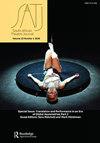Consumption and excess: South African Indian comedy and the stereotypical performance of identity in post-Apartheid South Africa
IF 0.2
0 THEATER
引用次数: 0
Abstract
Performing excess is a trope of comedy that dates back to the earliest times – with jokers and clowns being the most popular example of how comedy allows individuals to abandon restrictions of decorum and social graces. In a society where increasing democratic freedom allows for expressions of identity to be performed more openly, it is interesting to note how excess has been linked to the consumption of material goods, wealth and the caricatured performance of culture. Comedy, true to its nature, allows for these expressions of excessive consumption to appear even more pronounced than they do in other cultural products. In the South African Indian community, excess is used in an attempt to emphasize belonging in a market-driven capitalist economy and is also used to lampoon stereotypes of the rapacious Indian. Two main issues arise from depictions in South African Indian comedy. First, the South African Indian community has been associated with the stereotype of greed and rapaciousness, and the comedians (most prominently Karou Charou and Peru and Bala) are often criticized for allowing the use of stereotypical tropes to capitalize on the lampooning of the South African Indian community. Second, the exaggerated stereotypes reflect the state of comedy in post-Apartheid South Africa, with a heavy reliance on stereotypes and excessive displays of conspicuous consumption. The comedy in post-Apartheid South Africa, particularly from minority communities, has often been ‘low brow’, with an emphasis on excess, exaggeration of stereotypes and self-deprecatory humour. This excessiveness is prevalent in some South African Indian comedy, which relies heavily on stereotypes, such as that of bling township culture and excessive alcohol consumption, to provoke humour. This paper explores excess as an expression of consumption: how is consumption linked to comedy and how does this reflect the identity of South African Indians?消费与过度:南非印第安人喜剧与后种族隔离时期南非身份的刻板表现
表演过度是喜剧的一个比喻,可以追溯到最早的时代——小丑和小丑是喜剧如何让个人放弃礼仪和社交礼仪限制的最受欢迎的例子。在一个日益增长的民主自由允许更公开地表达身份的社会中,值得注意的是,过度消费与物质商品、财富和讽刺的文化表现之间有着怎样的联系。喜剧本质上允许这些过度消费的表现比其他文化产品更明显。在南非印第安人社区,过度被用来强调对市场驱动的资本主义经济的归属,也被用来讽刺贪婪印度人的刻板印象。两个主要问题出现在南非印第安人喜剧的描写上。首先,南非印第安人社区一直与贪婪和贪婪的刻板印象联系在一起,喜剧演员(最突出的是卡鲁·查鲁、秘鲁和巴拉)经常因允许使用刻板的比喻来利用对南非印第安人社区的讽刺而受到批评。其次,夸张的刻板印象反映了后种族隔离南非的喜剧状态,严重依赖刻板印象,过度炫耀消费。种族隔离后的南非,尤其是少数民族社区的喜剧,往往是“低调”的,强调过度、夸大刻板印象和自嘲幽默。这种过度表现在一些南非-印度喜剧中很普遍,这些喜剧在很大程度上依赖于刻板印象,比如炫耀城镇文化和过度饮酒,来激发幽默。本文探讨了过度作为消费的一种表现:消费如何与喜剧联系在一起,这如何反映南非印度人的身份?
本文章由计算机程序翻译,如有差异,请以英文原文为准。
求助全文
约1分钟内获得全文
求助全文

 求助内容:
求助内容: 应助结果提醒方式:
应助结果提醒方式:


